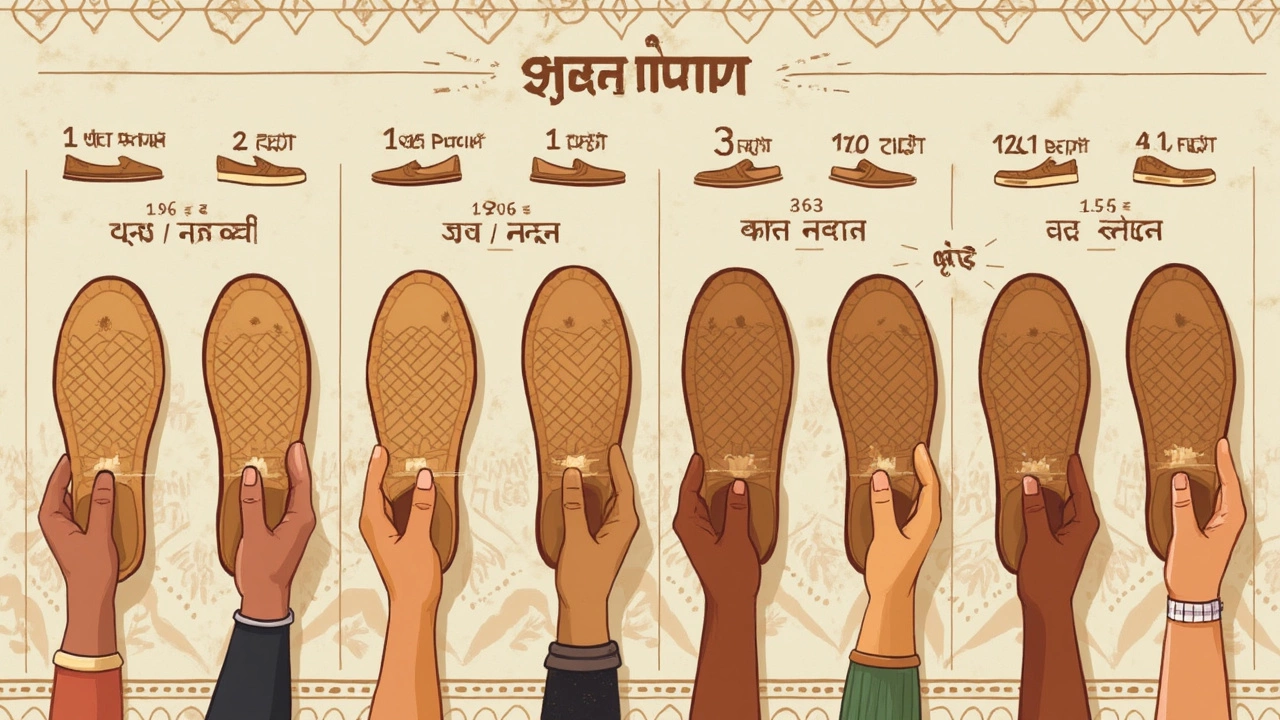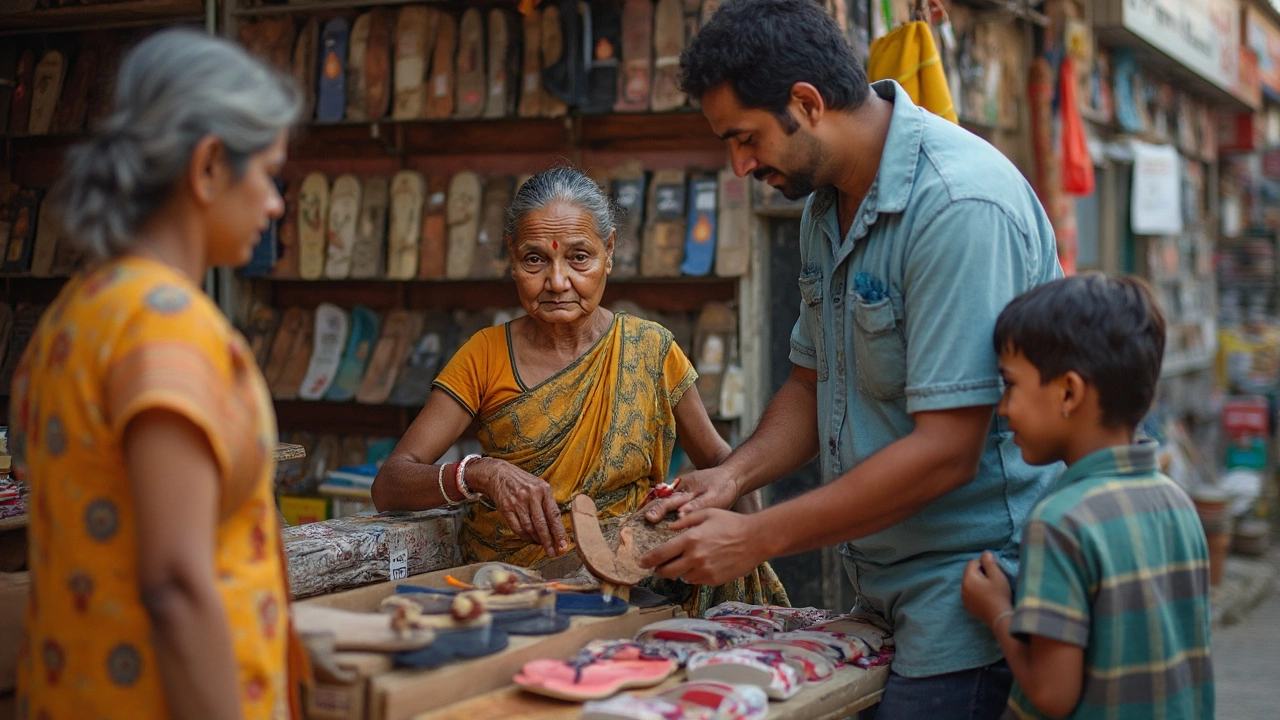Ever bought slippers in your regular shoe size, only to end up shuffling around like you’re wearing a clown costume—or worse, shoving your toes into a too-tight squeeze? It happens way more often than you’d think. Slipper sizes can be surprisingly inconsistent, and most people don’t realize how much brands differ until they try a pair from a new shop or website.
Here’s the wild part—you can pick a size 9 in sneakers, but with slippers, that “9” might feel loose, snug, or randomly perfect based on the brand and even the style. Want to know why? Slippers and shoes use different materials, construction, and sometimes they flat-out ignore the standard sizing game. No wonder slipper shopping can feel like a gamble.
- What’s the Deal with Slipper Sizing?
- Why Slippers Feel Different Than Shoes
- Brand Differences and Sizing Charts
- Tips to Find Your Perfect Slipper Fit
- Quick Fixes for Awkward Sizing
What’s the Deal with Slipper Sizing?
If you’ve ever wondered why slippers never seem to fit the same way as your regular shoes, you’re not alone. The truth is, slipper sizing is a bit of a mess, and there’s no single industry standard. Some brands try to match up with normal shoe sizes, but lots of them just don’t. They might group sizes (like S, M, L) or even use vague terms like "fits most." It leaves shoppers guessing and usually trying to remember if last year’s slippers were too tight or kept falling off.
The main issue? Slippers are made for comfort, not for perfect structure. Most use softer, thinner materials that stretch over time. While a running shoe has a rigid sole and shape, slippers are loose, flexible, and not built for long distances. Plus, some manufacturers just round the sizes out—like making “Medium” cover sizes 8-9, even if your foot is a true 8 or a wider 9.
Years ago, the American Podiatric Medical Association found in a survey that about 42% of people felt their slippers didn’t fit well. That’s a lot of people walking around with either their heels popping out or their toes curling. Here’s a look at just how slipper sizing usually lines up, but keep in mind that this table is only a typical example—actual fits can change by brand and style.
| Slipper Size | Women’s Shoe Equivalent | Men’s Shoe Equivalent |
|---|---|---|
| Small | 5-6 | 6-7 |
| Medium | 7-8 | 8-9 |
| Large | 9-10 | 10-11 |
| X-Large | 11-12 | 12-13 |
Check out the slipper sizes next time you shop, and don’t be surprised if your feet don’t agree with what’s on the tag. Size conversions are more of a suggestion than a promise in the world of slippers. It’s pretty common to have to size up or down depending on what you find most comfortable.
Why Slippers Feel Different Than Shoes
You’d think all footwear should feel about the same if the size matches. But slippers play by their own rules. The main thing you notice? They just don’t hug your foot the way sneakers or boots do.
First off, slippers skip the structure. Unlike an athletic shoe with its shaped insoles, stiff heel cups, and layers of foam or rubber, slippers are usually softer, more flexible, and way less padded. With many slippers, the material just flops around your foot. That’s comfy, but it also means your feet move differently, and things feel loose (or sometimes bunch up).
Check out this basic breakdown of why slippers and shoes feel so different:
| Feature | Typical Shoes | Typical Slippers |
|---|---|---|
| Heel Support | Moderate to high | Minimal to none |
| Insole Structure | Shaped/cushioned | Flat/soft |
| Materials | Stiff, durable (rubber, leather, etc) | Flexible, soft (fleece, cotton, foam) |
| Sizing Consistency | Standardized | Varies (brand and style matters) |
This design difference is why stepping into a slipper after a long day in work shoes feels relaxing but sometimes a little odd. Brands often make slippers with extra room for comfort. Some studies—even from big names like the APMA—point out that slippers run up to a half size larger than regular shoe sizes because your feet swell as you move around at home. That’s also why you can feel like you’re sliding out if you buy the same size you use for tight-fitting shoes.
Something else to watch out for: slippers can stretch out way faster. After a few weeks, they fit looser than when you first tried them on. If they’re lined with faux fur? That lining packs down, making them feel even bigger.
If you’ve ever questioned why house shoes keep tripping you up or flop around more than expected, you’re not alone. It’s totally normal, and knowing about these differences makes it easier to choose a pair that works for you instead of against you on the stairs!

Brand Differences and Sizing Charts
Here’s where things get frustrating: there’s no single, universal slipper sizing system. Each brand follows its own rules. Some stick close to regular shoe sizes, while others use their own charts that leave buyers scratching their heads. A quick look at popular brands shows just how messy it gets.
For example, UGG slippers tend to run a half-size big, while Dearfoams often run true to size. Some brands, especially those selling European styles, will label slippers with EU numbers like 42 or 43, which don’t line up exactly with US sizes. And a couple of brands even skip half sizes entirely. Is it any wonder you get confused?
To see what’s going on, check this straightforward comparison table. It shows official size advice from top brands. Notice how their guidance doesn’t always match up, even if the label looks the same.
| Brand | Typical Fit | Half Sizes? | Size Advice |
|---|---|---|---|
| UGG | Runs Large | No | Order one size down if between sizes |
| Dearfoams | True to Size | Some styles | Order your usual size |
| Isotoner | Varies by Model | No | Try on if possible, or check their chart |
| Vionic | Runs True | Yes | Order your usual size |
| L.L.Bean | Runs Slightly Large | No | Consider sizing down if you want a snug fit |
Some brands post detailed sizing charts online; others leave you guessing. The best plan? Don’t just trust the slipper size on the box. Look at the brand’s chart, and check whether they suggest ordering up or down. Reading recent customer reviews helps, too—people often let you know if a particular brand runs large, small, or just weird.
The wild variety is why you can’t take slipper sizes at face value. Always check a brand’s chart before ordering, especially if you’re switching brands or buying online with no chance to try them on first. Most brands know slipper shoppers have trouble, and a lot of sites give you a detailed guide these days—use it!
Tips to Find Your Perfect Slipper Fit
Getting the right slipper size is not just guesswork—it’s about knowing where things go wrong and having a game plan for finding what’s comfortable. Here’s what actually works if you’re tired of slippers that don’t fit right:
- Measure your feet before shopping—seriously, most of us just assume we know our foot size, but feet can change over time, especially if you’re on them all day or aging (yes, they can get wider!). Use a tape measure; jot down length and width. Match that up with the brand’s chart, not just your usual size.
- Check if the brand runs big or small. Most reputable brands or retailers will mention if slippers "run short," "true to size," or "bit roomy." Don’t ignore those notes—they can save you from sending things back.
- Look for actual foot measurements on size charts instead of just the usual US/EU numbers. Numbers without measurements are just a starting point, not a guarantee.
- Read reviews, especially ones that mention fit or break-in time. If lots of people say the slippers stretch after a week, factor that into your decision.
- Don’t get slippers too tight, hoping they’ll stretch. With cheaper foam or synthetic materials, they usually don’t. But things made from real wool or leather usually do widen a bit, so don’t go for an already loose fit in those.
- If you want to wear thick socks, order a size up. Otherwise, factor in your usual barefoot size.
Here’s what people report about slipper sizing, based on data from a 2024 retail survey (over 1,000 shoppers asked about their slipper fit):
| Slipper Fit Experience | % of Shoppers |
|---|---|
| Too Big When Worn Barefoot | 31% |
| Too Small Compared to Shoes | 27% |
| Perfect Fit Using Size Chart | 34% |
| Still Unsure After Reading Reviews | 8% |
The takeaway? Most people benefit from slowing down and double-checking sizing info, especially with brands they haven’t tried before. If you’re shopping online, stick with stores that do easy returns—you’ll stress less, and odds are higher you’ll finally land those slippers that fit like they should.

Quick Fixes for Awkward Sizing
So you ordered slippers in your usual size, and now they flop off your feet or crush your toes. Here’s the good news: you don’t have to send them back right away. There are some easy ways to fix slippers that are just a bit too big or a tad too small.
If your slippers are too loose, try these tricks:
- Wear thicker socks—sometimes, just switching from thin to fluffy socks fills in the space and stops the slip.
- Add insoles. Plenty of people pop a soft insole into oversized slippers. This can raise your foot a little and make the fit snugger.
- If they’re still sliding, look for stick-on heel grips. These are cheap, easy to apply, and help your heel stay put.
Too tight? Here’s what you can do:
- Use a shoe stretcher if your slippers are made from natural materials like leather or cotton. Leave it overnight and most of the time, you’ll notice a difference.
- Wear them around the house with thick socks for a few hours—the heat and pressure can help stretch them a bit if the material allows (just skip this if they're synthetic and inflexible).
If you’re dealing with a pair that’s clearly the wrong size—like your toes actually hang over the edge—don’t force it. It’s usually best to swap for the right size.
Let’s make it easier: here’s a quick look at common fixes and what type of material they work best with:
| Fix | Best For | Notes |
|---|---|---|
| Thicker Socks | Loose slippers, any material | Easy fix, instantly adds bulk |
| Insoles/Heel Grips | Loose slippers, fabric or leather | Adds snugness, cheap and quick |
| Shoe Stretcher | Tight slippers, leather/cotton/wool | Most brands suggest it for minor tightness |
| Break-In Wearing | Tight slippers, soft fabrics | Works only if slippers aren’t painfully tight |
One last thing—when shopping online for slipper sizes, always check the return policy. A lot of stores offer free exchanges, so don’t settle for the wrong fit if it just feels off. It’s worth the tiny hassle to get slippers you’ll actually want to wear.

